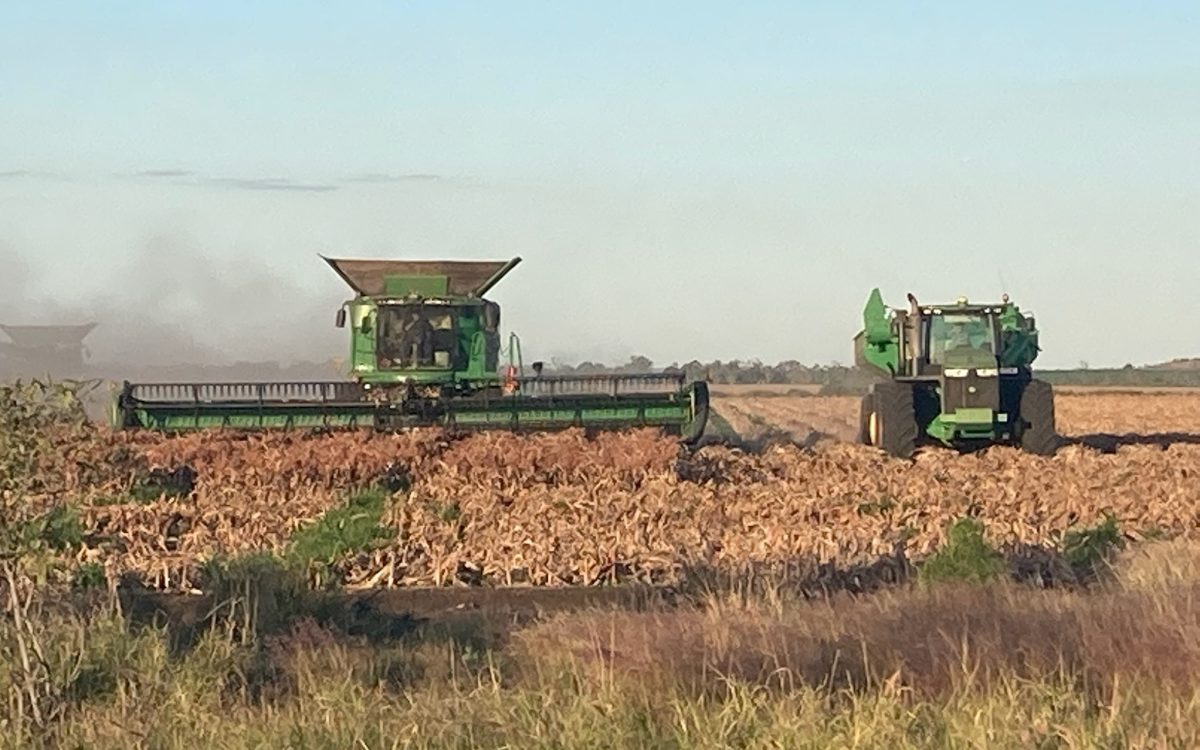
Harvesting sorghum near Capella in Central Queensland this week. Photo: Michael Vaughan, ADM
SOFTNESS in offshore markets and ready availability has contributed to feedgrain prices in south-eastern Australia dropping $15-$25 per tonne in the past week.
In contrast, northern values for white grains have held ground as growers in southern Queensland and northern New South Wales remain frantically busy completing their summer-crop harvest and getting the last of their winter crops in the ground.
This has made grain on farm in the north harder to find this week compared with the south.
| Today | Jun 16 | |
| Barley Downs | $460 | $460 |
| SFW wheat Downs | $470 | $470 |
| Sorghum Downs | $385 | $390 |
| Barley Melbourne | $430 | $455 |
| ASW wheat Melbourne | $465 | $480 |
| SFW wheat Melbourne | $460 | $475 |
Table 1: Indicative delivered prices in Australian dollars per tonne.
Poultry buys up big
Domestic demand in the northern market remains centred on SFW wheat and off-spec sorghum from the poultry sector.
Traders say rain-affected Sorghum X is trading delivered Downs at $285-$290/t, and is in ample supply from growers keen to sell it as soon as possible after harvest.
“There’s plenty around; being able to pick it up is the hard part,” one trader said.
SFW wheat is trading delivered Downs equivalent at $470/t, but shorts are paying $20/t or more in places.
Higher-quality sorghum is continuing to make its way by road to Brisbane’s export terminals for shipment to China at around $430/t delivered.
Robinson Grain commodity trader Anthony Furse said demand for containerised sorghum appears to have softened.
“The packing market has slowed down, and containers seem to be in short supply.”
“The sorghum market is softer.”
Mr Furse said some growers in southern Queensland have been pleasantly surprised by the quality of their sorghum harvested after rain.
“They might have been expecting sprouting of up to 20 per cent, and if it’s making 7-9pc, that gets them into Sorghum 2 at a much better price.”
Traders said inquiry from feedlots appeared to be subdued as toughening terms of trade temper ideas about how much grain will be needed in coming months.
“We’re getting very little inquiry from feedlots, and they seem to have enough bought to get them through.”
Northern growers are now in their closing fortnight of winter-crop planting, and some are engaging with new-crop multigrade contracts at around $460/t track for APW wheat, down from $500/t or so one month ago.
Wet conditions will prevent some growers from planting all their intended winter-crop area, which means a big summer-crop planting, including sorghum, is expected.
“We’re seeing a bit of new-crop sorghum trading at $360/t track March-April.”
South softens
Domestic and export demand from Port Adelaide continues to attract grain from western Victoria and south-western NSW, where growers are now turning their attention to pricing new-crop, and Victorian ports are also executing hectic export programs.
At Mildura, Grainwise broker Fabian Devereux said some growers had sold a small portion of their new-crop wheat based on multigrade contracts.
“New-crop sellers are online, and selling delivered January-June Geelong and Melbourne, but they’re not getting carried away,” Mr Devereux said.
“Consumers are booking grain out to August, and growers have more old-crop sold this time of year than normal.
“We’ve had a lot go to Port Adelaide and to consumers from the Mallee and into the northern Wimmera already.”
In Adelaide, Growth Grain Services principal Jack Zacker said consumers were relying on the trade to supply sites with grain.
“There’s not much left in growers’ hands now,” Mr Zacker said.
“Unless you’re talking faba beans and lentils, there’s very little left on farm.”
Mr Zacker said the cereal markets have fallen around $30/t in the past week alone.
New-crop delivered-Adelaide multigrade wheat contracts are today sitting at around $460/t for APW, down from $492/t last week.
Mr Zacker while some new-crop business was written with growers when the price was above $480/t, it has now dropped away.
“Generally when things fall $20-$30, people switch off.”
Growers in southern NSW, Victoria and South Australia have finished planting their winter crops, and while opening rain in many parts of SA was later than ideal, canola, cereals and pulses are generally off to a well-timed and strong start.
Grain Central: Get our free news straight to your inbox – Click here

HAVE YOUR SAY